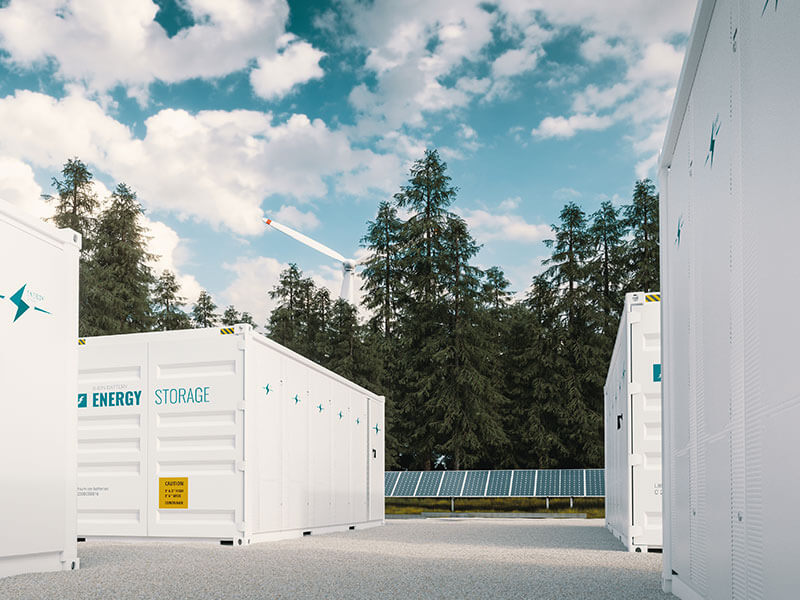Electricity storage stations for grids attracting attention for large-scale introduction of solar power; NTT Anode and Global Engineering take the lead

Grid power storage stations, which are connected to power transmission and distribution networks, are attracting increasing attention. This is because the Ministry of Economy, Trade and Industry is promoting the strengthening of support projects and the development of systems to spread the use of large-scale storage batteries, which are indispensable for mass introduction of solar power generation. NTT subsidiaries and Global Engineering are working on commercialization.
of renewable energy
Promoting main power source
On June 10, 2022, NTT Anode Energy (Chiyoda-ku, President Toru Takama), the NTT Group's renewable energy management company, will start a photovoltaic power generation system using a large-scale grid power storage station in cooperation with Kyushu Electric Power and Mitsubishi Corporation. A study on a joint project aimed at reducing the amount of output control has started in Fukuoka Prefecture in Kyushu. Japan has set a goal of net zero greenhouse gas emissions by 2050 and a 46% reduction compared to 2013 by 2030, and is promoting the use of renewable energy as its main power source.
On the other hand, when the amount of power generated by renewable energy exceeds demand, it is necessary to perform output control that wastes power generation. The three companies will jointly utilize their management resources and know-how to promote decarbonization through the effective use of power whose output is controlled and contribute to the stable supply of power through the creation of new controllability. It is an attempt to reduce the output control amount of photovoltaic power generation by using , and to increase profits in each market such as the supply and demand adjustment market and the Japan Electric Power Exchange (JEPX). Specifically, NTT Anode will install a 4,200 kWh system storage battery in Tagawa-gun, Fukuoka Prefecture, and Kyushu Electric Power will support the prospect of output control. Mitsubishi Corporation will oversee the entire project.
Battery cost is still high
difficult payback
The biggest weakness of solar and wind power generation is that the amount of power generated fluctuates greatly depending on the weather and time of day. Power storage stations for power transmission and distribution systems can absorb surplus power from renewable energy power plants, demonstrating their power as adjustment power for stable system operation. The power storage station will not be attached to a substation or renewable energy power plant, but will be connected to the grid independently.
However, large storage batteries are still expensive, and after storing surplus electricity, it discharges at the timing of tight supply and demand. Since it is not possible to sell electricity at a high operating rate like a power plant, it is still difficult to recover the investment.
In addition to the above-mentioned consortium of NTT Anode Energy, Kyushu Electric Power and Mitsubishi Corporation, there are two other companies that are already working on the development of power storage stations for grids. Global Engineering (headquartered in Fukuoka City), which handles electricity retail business and DR (demand control) business, and Mitsuuroko Green Energy (Chuo-ku, Tokyo), a power business subsidiary of fuel trading company Mitsuuroko. The two companies are making steady progress with the aim of starting operation of a large power storage station for the grid in 2022. Both companies are building power storage stations for the grid in Hokkaido. The storage batteries used by both companies are lithium-ion batteries made by Tesla in the United States.
Hokkaido at JEPX price
high volatility
A person in charge of Global Engineering said, "We are installing a power storage station for the grid in Chitose City, Hokkaido, because the Hokkaido area lacks the most adjustment power. In fact, JEPX spot prices in the Hokkaido area are the most volatile It is possible to make a steady profit by charging at times when demand is low and demand is low, and then selling electricity when prices rise due to high demand. Emphasize.
Since Hokkaido is separated from Honshu by the Hokkaido-Honshu HVDC Link, there is considerable room for grid power storage stations to be used to adjust supply and demand in Hokkaido, where a large amount of renewable energy is being introduced. The power storage station to be installed will have a capacity of 6,100 kWh and an output of approximately 1,500 kW. In the event of a power outage, the power storage station will be operated closely with local residents, such as supplying power to nearby residents to charge their mobile phones, computers, etc., and opening the company's exhibition hall to evacuation shelters. Also, if there is an opportunity, the company would like to consider introducing a power storage station for the grid in the Kyushu region, where output control occurs frequently.
Mitsuuroko Green Energy plans to start operation of a power storage station with a capacity of 12,192 kWh and an output of 3,085.6 kW in Kitahiroshima City, Hokkaido in December 2022. A spokesperson for the company said, "We will set up a power plant on a group company's idle land. Operation of the power storage station will be remotely controlled by our power supply and demand department." The Ministry of Economy, Trade and Industry is strengthening support for the introduction of storage batteries. If solar and wind power generation increases without supply and demand measures under the current situation, the investment profitability of solar and wind power generation plants will decrease due to the increase in the output control amount, and it is clear that it will become a hindrance to the spread of solar and wind power plants, and the use of storage batteries is essential. Because it becomes






